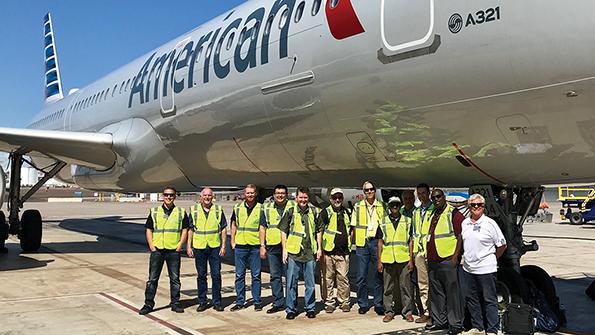
With the arrival of the Jan. 1 compliance deadline for automatic dependent surveillance-broadcast “Out” (ADS-B Out) functionality in the U.S., airlines are shifting to the promise and requirements of ADS-B In: the capability to display and exploit aircraft targets on the flight deck.
After years of trials involving several U.S. carriers, ADS-B In is no longer aspirational. In January, American Airlines plans to begin installing the SafeRoute+ ADS-B In retrofit system on its fleet of 319 Airbus A321s, an expected 4-5-year process. The airline completed certification flight tests on the narrowbody at Phoenix Sky Harbor International Airport (PHX) in September and October.
Originally as US Airways, with which it merged in December 2013, American has worked with SafeRoute developer ACSS—the joint venture of L3Harris and Thales—for nearly a decade to achieve ADS-B In functionality.
“It’s pretty exciting,” ACSS President Terry Flaishans says of the system’s entry into service. “All of the installation has been checked out, we’ve done our flight test, we’ve gotten the STC [supplemental type certificate] for the system, and we will start to install these in 2020. It’s going to be a very exciting time because immediately we will start looking for benefits [from] the ADS-B In system.”
SafeRoute+ is an upgrade to an aircraft’s ACSS TCAS 3000SP or T3CAS surveillance processor that avoids panel modifications on the flight deck by using the existing multifunction control and display unit and primary flight displays, with the addition of a small ADS-B Guidance Display (AGD). ACSS estimates the upgrade takes three days to complete.
The system currently supports five ADS-B In software applications: Enhanced Airborne Traffic Situational Awareness, Interval Management-Spacing (IM-S), Cockpit Display of Traffic Information, Assisted Visual Separation (CAVS), and In-Trail Procedures and Surface Area Movement Management.
ACSS first installed SafeRoute on UPS Boeing 757/767s in 2007, then provided applications for Delta Air Lines, JetBlue Airways, US Airways and American Airlines. Early versions of the system made use of Class 3 electronic flight bags (EFB) located to the side of the main instrument panel as the platform for display and control of the ADS-B In applications.
With the increasing adoption of tablet computers as EFBs instead of costly Class 2/3 mounted or installed units, ACSS moved to develop the SafeRoute retrofit solution. Adoption of integrated electronic standby indicators freed up panel space for the AGD.
The forward navigation displays present nearby ADS-B traffic for situational awareness; the graphical AGD supports more complex ADS-B In applications such as CAVS. A visual approach procedure, CAVS allows pilots to maintain separation during challenging visual conditions by presenting the differential ground speed between a lead and own-ship aircraft on the electronic display.

Expected benefits are reduced time on approach within 25 nm of the runway, reduced need for go-arounds and more efficient use of terminal airspace.
Recent progress in ADS-B In development has been reported on other fronts. In February 2019, the FAA, Honeywell, Alaska Airlines and United Airlines demonstrated IM-based “paired approaches” with lead and trailing aircraft at the San Francisco and Tucson airports using Honeywell prototype avionics.
During a paired approach, the trailing aircraft uses speed commands to maintain precise spacing from the lead (target) aircraft. Pilots are presented with a time-based spacing parameter, called the assigned spacing goal, which represents the desired spacing behind the target aircraft.
Airspace design and engineering company Mosaic ATM developed the experimental instrument-approach procedure, intended to increase the capacity of closely spaced parallel runways during instrument meteorological conditions.
Under the Air Traffic Management Technology Demonstration-1 program in early 2017, United Airlines and Honeywell tested the NASA-developed Airborne Spacing for Terminal Arrival Routes algorithm using EFBs to display the IM application with a chain of three aircraft—a United 737 and Honeywell’s Boeing 757 and Dassault Falcon 900 testbeds—at Grant County International Airport in Moses Lake, Washington.
Once its upgraded A321s enter service, American will participate in the ADS-B In Retrofit Spacing project, a two-year FAA demonstration designed to collect operational data and support future ADS-B In development. Benefits of ADS-B In applications will be measured within airspace managed by the Albuquerque air route traffic control center for westbound flights approaching PHX.
“In the past, the FAA and airlines and avionics manufacturers have worked on technical demonstration projects,” says Andrew Shutt, with the FAA’s Surveillance and Broadcast Services program. “What sets this project apart is that it is using commercially available avionics permanently installed in aircraft on revenue-generating flights, and using a large number of pilots and controllers.”
Transponders also will be updated to support ADS-B In. To comply with the ADS-B Out mandate, the FAA requires that operators equip with Version 2 DO-260B Mode S transponders and approved GPS position sources. The Version 2 standard has evolved since its original “Version 0” substantiation in the early 2000s to meet the mandate’s performance requirements.
An updated specification—DO-260C—that will support ADS-B In applications is under development. Standards organization RTCA’s Special Committee-186 for ADS-B has scheduled release of DO-260C minimum operational performance standards (MOPS) for next August.
DO-260C will correct issues identified since the publication of MOPS for DO-260, make revisions and implement additional information required for advanced Flight Deck Interval Management, according to the SC-186 terms of reference. It will make other improvements to support new ACAS X collision-avoidance logic and to accommodate unmanned aircraft and commercial space vehicles.
